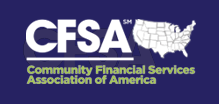In The News: Listen to History, Borrowers to understand impact of proposed rate caps
February 23, 2020 | CFSA Commentary
By D. Lynn DeVault
When developing policy, it’s common sense to listen to those who stand to be the most impacted. Yet attempts to enact a 36 percent annual interest rate cap on short-term, small-dollar loans are being guided by outside interest groups with little regard for the consequences or the financial realities of many Americans. Policymakers should examine history and reflect on how their proposals will impact those who use these loans, rather than let themselves be guided by those with no experience with the product.
Consumer financial services providers serve tens of millions of Americans every year, offering access to a broad range of credit products and financial services that customers value, including short-term, small-dollar loans. Regulating the annual percentage rate (APR) of these loans, which often have terms of two to four weeks, is misguided, as APR is a measure of annual interest and therefore is only meaningful for longer term loans of a year or more.
In addition, efforts to impose a 36 percent annual interest rate cap on these types of loans will restrict access to legal and responsible lenders, while at the same time doing nothing to address the underlying need for them or tackling the very real problem of unlicensed, illegal or otherwise unscrupulous lenders trying to take advantage of consumers. In fact, such poorly written proposals could have the unintended consequence of forcing millions of people to seek out dangerous alternatives from these unregulated lenders.
History has proven that arbitrary rate caps simply do not work. Dozens of financial institutions have tried to introduce cheaper substitutes for short-term, small-dollar loans, only to eliminate the products from their portfolios. The Federal Deposit Insurance Corporation (FDIC) also experimented with a 36 percent interest rate cap, but the loans simply weren't profitable enough for banks to continue offering the product.
South Dakota provides another recent example, having enacted a rate cap in 2016. A National Financial Capability Study conducted by the Financial Industry Regulatory Authority (FINRA) found that more South Dakotans reported having medical bills overdue and only paying the minimum on their credit cards in 2018 than in 2015, before the rate cap was in effect.
Industry critics recently paid for a survey to show that a majority of voters support a 36 percent rate cap. While the survey methodology has already been debunked, it is also worth highlighting that a 2016 survey by Global Strategy Group and the Tarrance Group, which surveyed both voters and borrowers, found that voters often had misperceptions about short-term, small-dollar loans that did not align with the reality borrowers reported. Virtually all borrowers – 96 percent – reported that they fully understood the terms of the loan, including interest rates and fees, before they took out the loan. Eighty percent of borrowers said that current requirements to take out a loan are enough, while less than half of voters agreed. Borrowers were also twice as likely as voters to believe that these loans are fairly priced for the value that they provide. Surveying individuals on annual interest rate caps when they do not have experience with short-term, small-dollar loans is careless at best and disingenuous at worst.
Ironically, surveying those with no regard for people who actually use short-term, small-dollar loans mirrors the approach that the Consumer Financial Protection Bureau (CFPB) took in its rulemaking under former Director Richard Cordray. More than 1 million customers submitted comments opposing the CFPB’s rule, including 400,000 handwritten letters telling their personal stories of how these products have helped them. Yet instead of considering the impact on customers, the CFPB proceeded with a rule that was crafted behind closed doors alongside the same advocacy groups and special interests now pushing misguided rate caps. We are hopeful that, under current Director Kathy Kraninger’s leadership, the voices of borrowers are considered as the Bureau moves forward with enacting consumer protections.
Policymakers should work to ensure that all Americans have access to legal and licensed sources of credit in their communities. If they listen to the actual experience of borrowers, it will be clear that an annual interest rate cap on all consumer loans will only restrict access to short-term, small-dollar loans and take away a vital source of credit for those who value and use these products to address their unique financial needs.
Read more in The Hill.

